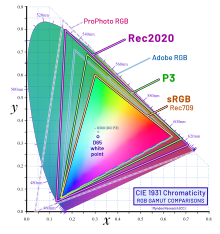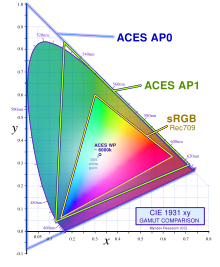User talk:Myndex
| This user is a member of WikiProject Color. |
| This user participates in the Filmmaking task force. |
| This user has an account on GitHub. |
I am currently researching color and human vision for Accessibility Standards.
Wiki Quick Help Links:
- The five pillars of Wikipedia
- Help pages
- How to write a great article
- Manual of Style
- Wikipedia:Where to ask a question, ask me on my talk page, or place
{{helpme}}on your talk page and someone will show up shortly to answer your questions. Again, welcome! -- Longhair | Talk 23:37, 14 August 2005 (UTC)
SOME KEY FILES FOR COLOR



Apologies...
if I sound/sounded moody on golden ratio, and if I caused you any offense. That article tends to attract a lot of problematic edits and so I was somewhat guarded. Thank you for your color and accessibility work; it's important but often forgotten. If you'd be willing, I'd appreciate accessibility critiques on the figures on Doyle spiral. Ovinus (talk) 04:59, 23 August 2022 (UTC)
- Understood... I'll review the Doyle Spiral page... For the record, I have a CVD simulator based on clinically tested math that is useful for dataviz like this: https://www.myndex.com/CVD/ Myndex talk 05:07, 23 August 2022 (UTC)
- Hey, this is actually really cool! Next time I make diagrams I'll be sure to pass it through. Ovinus (talk) 05:30, 23 August 2022 (UTC)
- So on the spiral page, I'd say nothing serious as far as the figures, but some things that could be adjusted to be a bit better. For the svgs with the blue/green spirals: Blue is usually best as the darkest color, though this blue is about in the middle. It's also close to the green in terms of luminance. As a personal preference, I'd make the blue darker and set the text to white, and the green lighter (keeping the "2" black). This will make the spirals more obvious as well.

- Luminance is KING
- Keep in mind that for all sighted users (everyone) we process details based on achromatic luminance, not color. Color can augment separation, but luminance is what drives our perception of shape, form, details, etc.
- So, when doing dataviz, and especially when things get small (as the circles do get very small) we want to ensure lots of luminance contrast, in addition to any color contrast therein. This is because our perception of contrast and details are very sensitive to spatial frequency. Higher spatial frequencies, i.e. smaller items, need more luminance contrast to be discernible.
- Hope this helps. I have more on contrast in general at https://git.myndex.com Myndex talk 05:40, 23 August 2022 (UTC)
APCA LaTeX
The current TeX text isn't rendering too well using MediaWiki's MathJax backend. Perhaps some workarounds like the following can be arranged?
- 0.0.98G-4g-base is mistaken as a mathematical expression; this should affect standard TeX too. do textit: . The entire string is ideally made textit, although the alignment point in Contrast requires breaking out.
- textstyle does not seem to do anything. textrm works though: ,
- Yeah, MathJaX is not great with macros, even
\, in textrm -- it's some sort of intentional simplification. Gotta use individual textrm bits stringed together with\instead...
Artoria2e5 🌉 16:38, 21 August 2023 (UTC)
- Hey @Artoria2e5 thank you for the tips... Since we are on the subject, here's a question: I wrote this math out in reverse notation, so the input is at the bottom of the page, and result is at top... I've been debating if I should simplify, and also use forward notation or algorithmic (pseudocode) notation.... so I'm collecting opinions... Myndex talk 11:39, 30 August 2023 (UTC)
- I think using the forward direction would be nicer. I also noticed that sRGB is using an exponent of 2.4 in your 4g-base (user page and https://github.com/Myndex/SAPC-APCA/blob/master/documentation/APCA-W3-LaTeX.md), which a bit unexpected.
- For the sake of generality, maybe we should just tell users to get the Y value from the usual XYZ(D65) translation, then in an appendix include the Y part of sRGB#From sRGB to CIE XYZ? That would also automagically translate APCA to other SDR color spaces like Display P3. Artoria2e5 🌉 03:44, 1 September 2023 (UTC)
- Hi @Artoria2e5 the linearizing exponent choice is intentional, in retrospect it might have been better to make it 2.5 or 2.35, just to prevent comparison to sRGB. I describe the rationale in more detail in the documentation folder "regarding exponents". The short answer is this is a pre-shaping that is relative to estimated perceived screen luminance Ys, and it also helps adjust certain saturated colors toward perception.
- There is already a P3 and Adobe98 input module., and IMO an accurate contrast prediction is more challenging than simply transiting the standard XYZ... XYZ is a neutral touchstone, sure, but there is nuance among various color spaces that are not necessarily considered with a straight transform (which is why there's choices of absolute, perceptual, etc in ICC-land). With APCA I've been concerned only with emulating or estimating the HVS actual perception of self-illuminated displays, and not round trips or interchange or gamut mapping.
- That said, I'll mention that CIEXYZ is based on the vision of ~16 young white British males in the 1920s... you know, for diversity... and most colorimetry recites that, and that's fine for a lot of applications like color matching. But supra-threshold contrast between adjacent colors is different than finding JND between two colors, and the HVS behavior is different. In that regard, I've been considering Stockton&Sharpe sharpened cone responses, or perhaps Judd/Vos, instead of the 1931 standard observer. Myndex talk 15:34, 1 September 2023 (UTC)
- That makes some sense. I get the doubt around old XYZ, but one thing stopping us from just moving to a new system (like XYZF based on Stockton&Sharpe cones) is that every color space we have is defined around 1931 XYZ. Given a display's real spectrum for each primary color, you can probably make use of S&S by a pipeline that goes sRGB → spectrum → XYZF, but that's a lot of assumptions to be made about the display. Artoria2e5 🌉 09:53, 2 September 2023 (UTC)
- @Artoria2e5 yes it is, and I haven't made that change yet, and I'm considering these things... But the one thing that we generally know about displays, are the assumed coordinates of the primaries and white point.
- For the purpose here, to predict contrast, we're not concerned about roundtrips or in terms of matching a gamut or anything else. Our only real interest here is in modeling how displays are perceived, and how we can adjust our perception model to various visual impairments. Myndex talk 15:28, 2 September 2023 (UTC)
- That makes some sense. I get the doubt around old XYZ, but one thing stopping us from just moving to a new system (like XYZF based on Stockton&Sharpe cones) is that every color space we have is defined around 1931 XYZ. Given a display's real spectrum for each primary color, you can probably make use of S&S by a pipeline that goes sRGB → spectrum → XYZF, but that's a lot of assumptions to be made about the display. Artoria2e5 🌉 09:53, 2 September 2023 (UTC)
ArbCom 2024 Elections voter message
Hello! Voting in the 2024 Arbitration Committee elections is now open until 23:59 (UTC) on Monday, 2 December 2024. All eligible users are allowed to vote. Users with alternate accounts may only vote once.
The Arbitration Committee is the panel of editors responsible for conducting the Wikipedia arbitration process. It has the authority to impose binding solutions to disputes between editors, primarily for serious conduct disputes the community has been unable to resolve. This includes the authority to impose site bans, topic bans, editing restrictions, and other measures needed to maintain our editing environment. The arbitration policy describes the Committee's roles and responsibilities in greater detail.
If you wish to participate in the 2024 election, please review the candidates and submit your choices on the voting page. If you no longer wish to receive these messages, you may add {{NoACEMM}} to your user talk page. MediaWiki message delivery (talk) 00:05, 19 November 2024 (UTC)



